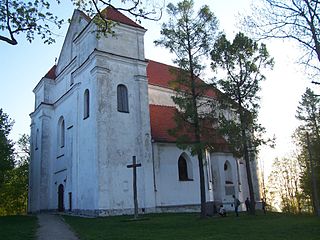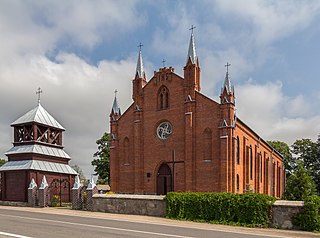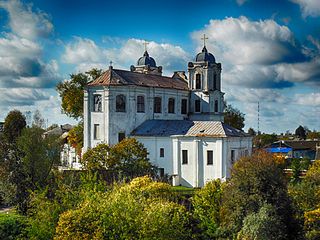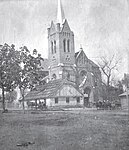
Minsk is the capital and the largest city of Belarus, located on the Svislach and the now subterranean Niamiha rivers. As the capital, Minsk has a special administrative status in Belarus and is the administrative centre of Minsk Region and Minsk District. As of 2023, it has a population of two million, making Minsk the 11th-most populous city in Europe. Minsk is one of the administrative capitals of the Commonwealth of Independent States (CIS) and the Eurasian Economic Union (EAEU).

Mogilev, also transliterated as Mahilyow, is a city in eastern Belarus. It is located on the Dnieper River, about 76 kilometres from the border with Russia's Smolensk Oblast and 105 km from Bryansk Oblast. As of 2011, its population was 360,918, up from an estimated 106,000 in 1956. It serves as the administrative centre of Mogilev Region, and is the third-largest city in Belarus.

Baranavichy is a city in Brest Region, western Belarus. It serves as the administrative center of Baranavichy District, though it is administratively separated from the district. As of 2023, it has a population of 172,150. It is notable for an important railway junction and is home to Baranavichy State University.

Lahoysk is a town in Minsk Region, Belarus. It serves as the administrative center of Lahoysk District. As of 2023, it has a population of 15,515.

The Belarusian Greek Catholic Church or the Belarusian Byzantine Catholic Church, is one of the 23 Eastern Catholic sui iuris particular churches that are in full communion with the Holy See. It is the heir within Belarus to the Union of Brest and the Ruthenian Uniate Church.

The Church of Saints Simon and Helena, also known as the Red Church, is a Roman Catholic church on Independence Square in Minsk, Belarus.

Zhyrovichy Monastery is an Orthodox monastery in Belarus, in the village of Zhyrovichy.

The Holy Spirit Cathedral or the Holy Ghost Cathedral, is a cathedral in Minsk, Belarus. Consecrated in honour of the Holy Spirit, it the mother church of the Belarusian Orthodox Church. It was built between 1633 and 1642 as a part Bernardine monastery during the Polish–Lithuanian Commonwealth in a place of former male Orthodox monasteries. The site became Orthodox again in 1860. The cathedral is listed as a Belarusian Cultural heritage object and is considered one of the main landmarks in Minsk Upper city.
The following is a timeline of the history of the city of Minsk, Belarus.

The Transfiguration Roman Catholic Church in Novogrudok, Belarus, is a Baroque church erected in 1712–1723, replacing an earlier Gothic building from the late 14th century, and originally consecrated under the title of Corpus Christi. Two Gothic chapels survive and are included in the Baroque building.

Catholic church of the Assumption of the Blessed Virgin Mary is a Roman Catholic church in Pružany, Belarus. Monument of neoclassical architecture.

The architecture of Belarus spans a variety of historical periods and styles and reflects the complex history, geography, religion and identity of the country. Several buildings in Belarus have been designated as UNESCO World Heritage Sites in recognition of their cultural heritage, and others have been placed on the tentative list.

Church of the Holy Trinity is a Roman Catholic church in Gierviaty, Grodno Region, in Belarus. It is an example of the Belarusian Neogothic architecture and was built in 1899–1903. The church is a site of cultural heritage of Belarus.

Church of Saint Andrew Babola in Narach is a Neo-Gothic Roman Catholic church in Minsk region, Belarus, built in 1897–1901. Nowadays the church belongs to the Discalced Carmelites.

Church of Charles Borromeo is a former Roman Catholic church in Pinsk, Belarus. Constructed between 1770 and 1782, it was consecrated in the name of St. Charles Borromeo, then reconstructed in the second part of the 19th century and dedicated to the Holy Trinity.

Church of Saint Mary in Višnieŭ is a Catholic parish church in Minsk, Belarus. It was constructed in 1637–1641 on the banks of Holszanka river. The church is listed as a Belarus Cultural Heritage object.

The Church of Saint Virgin Mary in Rakaw is a Catholic church in Minsk Region, Belarus. It was constructed between 1904 and 1906 on the bank of the Islach river and consecrated in the name of Our Lady of the Rosary. The church is listed as a Belarusian Cultural Heritage object.

The Church of Saint Mary in Miadziel, Belarus, is a Catholic church, listed as a Cultural Heritage object. The church was constructed in 1754 for the Discalced Carmelites' monastery.

Church of Saint Anthony of Padua in Dwarec is a Roman Catholic church in Belarus, listed as a national Cultural heritage monument. In some sources it is called Corpus Christi church.

Church of the Assumption of the Blessed Virgin Mary in Mscislaŭ is a Belarusian Cultural Heritage object, built in 1617–1637 and restored in 1746–1750 by Johann Christoph Glaubitz. It is considered the most valuable historical monument of Mstsislaw. The church was originally constructed for Carmelite monastery and consecrated in honour of the Blessed Virgin Mary only in the 18th century after restoration.
























